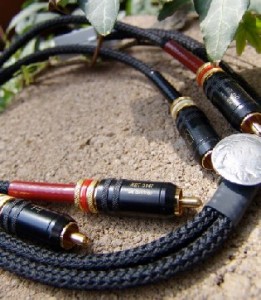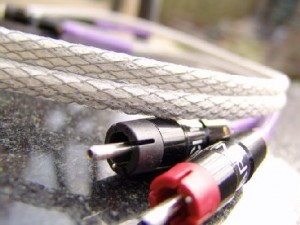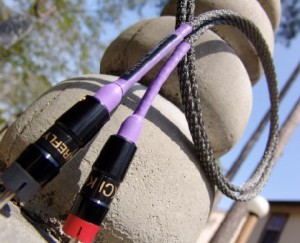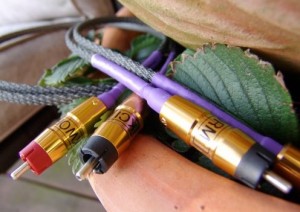Only a precious few earth dwellers dabble in the world of high-end stereo. The cold, hard truth is that most folks either don’t know or could not give a s#*t about the effort to pursue better sound. That’s fine. Leave the uninitiated to their Best Buy and Wal Mart specials while we audiophiles bask in a land rich in fine crafted component jewelry. After all, not everyone was meant to ‘get it’ /< insert snub face with nose in the air /<. Yet within this special interest group some refer to as Audiophilia, there exists heavy debate over something considered by many as voodoo. I’m talkin’ about high end cables.
Ah yes, cables – the one topic guaranteed to tickle the hairs on the neck of even the most liberal of audio veterans. It’s the one component in the audio chain that draws a distinctive line in the sand between the gospel and the cynics. For all intents and purposes, however, this article is not designed to act as the great equalizing parchment drawn to bring peace throughout audio land. Instead, this article observes, nay, even illustrates, the differences of some very well respected interconnects. So hear ye, huddled masses of the converted and non-converted alike, I bring to thee a comparison of KCI’s finest.
Kool Cables, INC or KCI for Short
Even today’s text-happy teenagers would be hard-pressed to dream up such an uncool name. Kool? I thought that died in the early 90s, right along with MC Hammer pants. Despite the lip curling name, John Prator, sole proprietor of KCI, has gained quite the reputation for offering some seriously good interconnects. Nearly every customer testimonial to date has read the same: an enthusiastic overview of how John’s relatively affordable cables out-performed their former megabuck, audiophile approved garden hoses. You could say that it’s now become something of a buzz.
Peeking behind the scenes of KCI, I found a humble operation rooted in a very simple foundation. At KCI, you won’t uncover a team of mad scientists running sweeps and measurements in an effort to create the perfect cable. Instead, what you’ll find is a product that is the result of accumulated experience and strong intuition. Naturally, John has a few tricks up his sleeves, but for the most part, this early success can be greatly attributed to John’s extensive knowledge of and passion for exotic metallurgies and his approachable, “Aw, shucks” attitude.
How it’s goin’ down
Some people emphatically insist that the only way to honestly and accurately assess the differences between two products is through comprehensive, blind A/B/X tests. I’m not one of those people. This review was approached using the tried and true method of utilizing components of different topologies, followed through with a lot of listening.
Assuming critical front-end duties during the evaluation was the Docet-Lector 0.6 CDP MKIII and the Abbingdon Music Research CD77. Amplification was handled by the Vista Audio i84 and the Karan Acoustics Ki-180 integrated units. For speakers, I turned to Totem Acoustic’s Sttaf, Forest, and Dali’s Mentor 5 mini-towers
Every in-depth evaluation needs a control. In this instance, that control is the Totem Acoustic Sinew – an affordable interconnect that has served as my personal reference for well over a year. To keep things fair, I used a brand new set of Sinews, clocking them with same amount of burn-in hours as the other cables.
Totem Acoustic Sinew
- Conductor Type: OFC Copper
- Connector Type: WBT-0147 Locking Plugs Insulator: Cotton and Silk Component Retail: $300 USD (0.8m)
If you haven’t heard of the Sinew, you’re not alone. When most people think of Totem Acoustic, thoughts of slim two-way loudspeakers and tricked-out native-themed rooms spring to mind. Yet for years, Totem has silently offered what may be one of the better-kept secrets in the world of luxury interconnects.
Performance Summary: The Yin
Vince Bruzzese crafted the Sinew to integrate well into nearly any high end audio system. What he ended up with was a jack-of-all-trades interconnect that pulls off damn near every audio trick in the book, all the while keeping true to its roots. Simply put, the Sinew is one hell of a versatile interconnect. No matter what I’ve tied it to, be it a euphonic single ended triode or a razor sharp class D switching amplifier, the Sinew has remained faithful to its vivid persona. There is something to be said for dependability and consistency.
There is also something to be said for a cable that can churn all of those wonderful and often convoluted audiophile adjectives. Fear not, my brothers and sisters of a critical ear, the Sinew gives you plenty of goodies, such as exceptional detail retrieval, wonderful low level resolution, clean and extended highs, a super fast and harmonically engaging midrange, along with clean, dynamic, and effortless sounding bass. Make that a lot of bass.
Keeping true to Totem lineage, the Sinew’s most salient, yet not so surprising attribute is its ability to throw out a tremendous holographic soundstage. None of the other cables in this comparison was able to match it in this regard. The Sinew also holds a distinct edge in the ability to deliver convincing levels of acoustic energy,something that became particularly noticeable on full scale orchestra pieces. Crescendos retained more energy. Tympani strikes in particular had…. well, more balls.
Performance Summary: the Yang
Now that I’ve made the Sinew out to be the God among interconnects, its time to bring it back down to mere mortal flesh and bone. For all the Sinew can do, it could benefit from a touch of refinement at its frequency extremes. The treble, while extended and detailed, can sound ever so slightly rough in direct comparison to cables with a smoother and more refined top end. The bass, while full and detailed, can often lose some of its composure during heavy bass passages. Although these faults can be considered sins of omission in light of all the Sinew’s strengths, they are nonetheless a part of its whole, one that cannot be manipulated.
Recommendations
There aren’t too many safe bets in audio. The Sinew may be one of them. It is one of the few cables I’ve stumbled across that can blend well into just about any situation. The only circumstance I’ve ever found the Sinew to perform badly is when thrown into a system that exudes a bit of thinness in the upper midrange/lower treble. Otherwise, this super flexible, no bullshit interconnect has got the goods necessary to take any system to potentially greater heights.
KCI Mandarina
- Conductor Type: Gold Alloy
- Connector Type: Eichmann Copper Bullet Plugs (review sample used silvers)
- Insulator: Teflon and Silk
- Component Retail: $299 USD (1M) (add $69 for silver bullet plugs)
Initially designed to give a taste of the Silkworm at less than half the cost, the Mandarina is a beautifully-voiced product that is much more than a mere consolidation of its big brother. If your ears are regularly drawn towards components with musical soul, the Mandarina may very well be your sledgehammer.
Performance Summary: The Yin
Hear ye, midrange fanatics: there’s a new contender in interconnect town. Woven deep within the aural fabric of the Mandarina is a deliciously full and rich sounding midrange that simply oozes texture. If you are a vocal and acoustic aficionado and value a component that can ace the ability to recreate a palpable sense of scale, tone and realistic note decay, the Mandarina should immediately receive a first-class pass to your short list.
Building upon the midrange section is bass that’s both warm and prominent. While the Mandarina lacks an iron grip, it makes up for it by offering copious levels of low end output and impact. Combine the above characteristics with a smooth and easygoing high end, along with exceptional soundstage depth and air, and you’ve got a cable that’s hard not to love.
Performance Summary: The Yang
Yet for all that it is, the Mandarina can claim few technical achievements over its peers. The Silkworm is more refined and articulate, while the Firefly is more transparent and linear. Its highs could also benefit from a bit more finesse, as could the bass. When slipped into euphonic sounding systems, the Mandarina may tip the balance too far towards the mid-band extreme.
Recommendations
The Mandarina speaks with distinctive flair. Like the touch of warmth from a triode on a cold winter’s day, the Mandarina’s raw musical prowess amounts to an expressive sound that is more than just a shadow of the Silkworm. If you find yourself searching the narrows for a high end cable that has a bit of spice, or are flat out tired of the rat race and want to bring home a cable that can settle into your system for the long haul, the Mandarina may be for you.
KCI Firefly
- Conductor Type: Silver
- Connector Type: Eichmann Copper Bullet Plugs (review sample used silvers)
- Insulator: Teflon and Silk
- Component Retail: $349 USD (1M) (add $69 for silver bullet plugs)
Selling silver cables is tough job. Sure, using pure silver as a main conductor may have been considered cutting edge a few years ago, but that was sooo yesterday. Nowadays, silver interconnects and speaker wires are abundant and certainly do not inspire the same frenzy and excitement as the latest class D amplifier. Having dabbled with a number of these exotic cables in my travels, I admit to having a sort of pseudo-confidence on what the silver biz is all about. Then came along the Firefly, a tiny little interconnect that took me to school – reminding me that nothing in this hobby is completely ‘linear’.
Performance Summary: The Yin
Getting right to it, this is no ordinary silver interconnect. Then again, it was never meant to be. John Prator’s goal was to create a cable that could encompass all the benefits of silver while avoiding the conductor’s well-documented pitfalls. His solution is the Firefly, a brilliant little interconnect that practically abolishes the oft lean, harsh, and dry tendencies of silver. The elimination of these pesky artifacts transfers into performance that, in a number of ways, outshines even the star-studded Silkworm.
Strides from the Mandarin’s colorful persona, the Firefly is a well polished dominatrix that speaks clearly and takes shit from no one. In other words, it’s my kind of cable. As expected, part of the Firefly’s assets flow in direct lineage with its silver brethren, offering outstanding speed, articulation, resolution, pinpoint soundstaging and transparency. Yet these wonderful attributes are not what makes the Firefly so special.
What makes the Firefly so special, dare I say even first class, is its neutral presentation that passes along the signal relatively unabated, allowing the music and components to speak for themselves. Every single time I inserted the Firefly into my system, the clarity gained was akin to getting new prescription glasses. This is a cable that will let you see deep into the aural landscape, and can do so without fudging up the most important part of reproduction, emotional connection.
Performance Summary: The Yang
While the Firefly manages to successfully free itself from the main caveats of silver, it nonetheless retains a slightly cool character. While this trait can hardly be considered detrimental to overall performance, it nonetheless warrants mention. Otherwise, the most damning part of the Firefly has little to do with raw performance and everything to do with break-in time, which hovers around the 300 hour mark.
Recommendations
First impressions have great impact. Unfortunately, they can also be misleading. Out of the box, the Firefly takes on the atypical garden variety silver sound. I’m not embarrassed to admit that I came close to writing off the cable for what I thought it was. After all, I’ve been down this path more than once. Thankfully, a long saturation of constant signal allowed the Firefly to come into its own. The best piece of advice I can give any future Firefly owner is to be patient, and put some serious hours on the cable rather than rushing to conclusions. Give it enough time, and you will be treated to a smooth, high-octane performer that breathes life into the music with ‘tell it like it is’ bravado.
KCI Silkworm
- Conductor Type: 24 Karat Gold
- Connector Type: Eichmann Silver Bullet Plugs
- Insulator: Teflon and Silk
- Component Retail: $899 USD (1M)
There’s a new a buzz word circulating through the virtual circles: Silkworm. You wont have to dig deep into a forum’s archive to uncover a number of well-seasoned audiophiles waxing eloquent on how this ultra-flexible, pure gold interconnect won them over. If there were any doubt to the Silkworm’s reputation, just ask John Prator. Despite the Silkworm’s posh shelf tag, it continues to rank as his best seller. The question is, does the performance meet the hype, or is this just another flavor of the week?
Performance Summary: The Yin
This exotic cable, created to bridge the traditional lines that separate transparency and color, is a truly world-class interconnect that aces nearly every critical aspect of sound reproduction. Speaking with a refined, yet approachable warm voice, the Silkworm manages to accomplish uncommonly adept system integration. You will be hard-pressed to find a rig the Silkworm won’t perform well in.
These cables do just about everything exceedingly well. They’ve got a hauntingly realistic soundstage, great low level resolution, an airy and detailed high end, a textured and clean midrange, along with deep and tight bass. Some will claim that the Silkworm’s piece de resistance is its precise and layered imaging. I say it’s the Silkworm’s tone. What I hear from the Silkworm when tasked to recreate instrument period flutes, lutes, and vocals is a believable rendition of what I hear while strumming around the historical part of colonial Williamsburg.
Yet the most charming trait of the Silkworm is the way it allows you to soak in musical goodness without exciting audio nervosa. It sings in a way that allows you to forget about the mechanical facets of sound reproduction. Just plug them in, then sit back and let the music envelop you.
Performance Summary: The Yang
Let’s face it, on some level, we all want the perfect audio component that is all virtue and no vice. So what keeps the Silkworm from being the end/all, be/all interconnect? For starters, owing in part to thin gauge, it’s not the most dynamic cable of the bunch. Although I suspect most audiophiles will find the Silkworm’s dynamic prowess satisfactory, it’s worth mentioning that cables like the Totem Acoustic Sinew and the KCI Firefly can out-gun it in this regard. Otherwise, much like the Firefly, the Silkworm requires a lot of break in. During this period, the Silkworm will exhibit very strong Dr.Jekyll / Mr.Hyde tendencies. Just be patient and allow at least 150 hours before passing judgment. Lastly, this cable becomes quite pricey when you require lengths greater than 1.5m. Don’t blame John. Blame it on the rising cost of pure gold.
Recommendations:
The Silkworm is for anyone looking to take his existing system to a new plateau. You needn’t worry about whether or not this cable will integrate into your system. [Baring the most euphonic of systems, it will. If you lust for an exotic, do-it-all cable and do not mind a touch of color, the Silkworm may be your ticket off the high end cable merry-go-round. Highly recommended.
Final Conclusion
John’s product line may be small, but it is incredibly well-rounded. Every product offers unique styling and voice. Listeners who thirst for lush harmonics and rich texture will find what they are looking for in the Mandarina. For slightly more dinero, you can step into first class transparency and articulation with the Firefly. Then you have the Silkworms, KCI’s flagship model that gives you a balanced taste of both worlds.
The internet buzz looks to have merit this time around. KCI is offering products that should be taken very seriously. Top notch build quality. Top notch sound quality. Top notch customer service. There is nothing left wanting. Mark KCI down as one of those brands every audiophile should experience. So with a tip of the hat to John Prator on his wonderful array of interconnects, this is Sean signing off.
external link: KCI cables @ www.koolcables.com
 from affordableaudio, By Sean Fowler
from affordableaudio, By Sean Fowler




